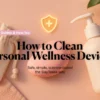
Intro
Intimacy can change after treatment—and that’s okay. Healing is personal, non-linear, and there’s no “right” timeline. This guide centers comfort, consent, and communication, then offers gentle, body-safe options and partner tips. It’s pressure-free and inclusive; take what helps and skip the rest.
Start with comfort (body image, energy, sensory changes)
- Body image & scars: It’s normal to have mixed feelings. Try soft lighting, clothing you feel good in, and self-touch at your own pace to relearn comfort.
- Fatigue & bandwidth: Plan intimacy for times of day you have more energy; short, sweet moments count.
- Sensory shifts: Numbness, tenderness, or altered sensation can happen; explore non-surgical areas first (hands, back, scalp massage).
- Environment: Warm room, soft fabrics, unrushed time, “no goal” mindset.
Consent & communication (scripts you can actually say)
Try these openings:
- “I want closeness, but I need to go slow tonight.”
- “These areas are okay to touch; these are off-limits for now.”
- “Let’s check in every few minutes—green/yellow/red?”
If you feel pressure: - “I’m not ready for that yet; can we stay with [holding/massage/hand-to-hand]?”
Partner check-ins: - “How is this pressure?” • “Any spots to avoid?” • “Want to pause or change?”
✔ Yes
- Hand massage
- Back rub or shoulder touch
- Soft lighting and cozy clothes
- Cuddling while watching a movie
❔ Maybe
- Exploring with clothes on
- Trying new lotions or textures
- Kissing or gentle hugging
- Talking about what feels safe today
✖ No
- Pressure to “go further”
- Comparing to before treatment
- Touching areas that still feel sore
- Making jokes about scars or bodies
Pacing & pain (when to pause, when to get help)
- Go slow: Warm-up > touch > feedback > decide next.
- If something hurts: Stop, breathe, switch to a comfortable activity.
- Vaginal dryness/discomfort: Consider fragrance-free, body-safe lubrication and soothing external balms; check with your clinician for options if you’re on hormone-sensitive treatments.
- When to seek help: Persistent pain, bleeding, or distress—see a clinician; ask about pelvic floor physical therapy or a certified sex therapist.
Body-safe, non-explicit product categories (gentle ideas)
- Soft fabrics & comfort pieces: wire-free bras, modal/silk layers, soft cardigans.
- Soothing balms (external): fragrance-free, dermatologist-tested options for sensitive skin.
- Lubricants (body-safe basics): water-based or high-quality silicone; avoid heavy fragrance or potential irritants; patch-test first.
- Gentle relaxation massagers: quiet, low-intensity devices for shoulders/back/legs; think stress relief, not performance.
Compare-at-a-glance
- Water-based lubes: easy clean, compatible with most materials; may need reapplication.
- Silicone lubes: longer-lasting, very slick; avoid with silicone devices.
- External balms: look for short ingredient lists; avoid strong perfumes.
Read next: Product Guide Hub → (your URL)
Partner support (what to do, what to avoid)
Do: ask instead of guessing, celebrate small wins, manage household tasks, protect privacy, make space for mixed emotions.
Avoid: timelines/pressure, comparing to “before,” unsolicited advice, jokes about bodies.
Connection menu (no-goal closeness): hand massage, scalp massage, cuddle + audiobook, tea on the couch, a gentle walk.
When to see a professional
- Pelvic health PT: for pain, scar mobility, pelvic floor coordination, and graded return to comfort.
- Sex therapist (certified): for communication, desire differences, anxiety/trauma-informed support.
- Medical team: for medication side effects (dryness, hot flashes), skin reactions, or new symptoms.
(html: medical note — “Informational only; follow local guidance and your clinician’s advice.”)
🩷 Read next:
FAQs
There’s no universal date. Ask your clinician based on surgery type, recovery, and any ongoing treatments. Start with gentler forms of closeness.
Desire can follow comfort. Reduce pressure, try “no-goal” touch, and talk to a therapist if low desire causes distress.
Possible dryness, scar sensitivity, muscle guarding, or medication effects. Use lubrication, go slowly, and seek pelvic floor PT/clinical advice.
Ask what’s helpful, slow down, avoid assumptions, take on practical tasks, and celebrate small steps together.
Use fragrance-free, body-safe basics and check with your clinician, especially with hormone-sensitive treatments.







